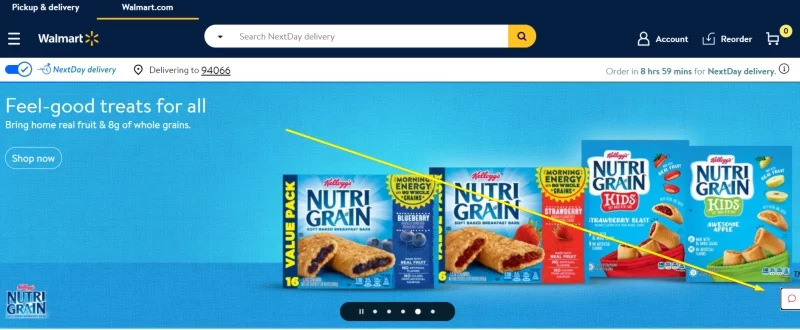8 Best Ways to Collect Customer Feedback on Your Website
Are you wondering why you don’t get more repeat customers? Have you looked at your website’s bounce rate confused because you’ve optimized the site for conversions? The answers to these questions are not that hard to get to. But you’ll need to start collecting customer feedback on your website to learn from your customers’ experience.
You might have errors within your website that make ordering difficult. Or your customer service options are lacking compared to your competitors. Your customers might struggle to find what they’re looking for on your website.
So while you might think you’ve done all that you can to make your website and customer experience excellent, you’ll never be able to see it as clearly as your customers do.
According to Reputation Refinery, 96 percent of unhappy customers won’t tell you that they’re unhappy. However, they will tell 15 friends about their disgruntled feelings, which doesn’t bode well for expanding your network and reaching new customers.
Table of Contents
Giving Customers a Sounding Board

Not only is your business suffering through losing a repeat customer due to a poor experience, but you risk reputation problems since that disgruntled customer is telling their friends.
To prevent this from happening, angry customers need a sounding board. They need to feel heard and like their feelings are justified.
Offering customers a chance to provide feedback on your website can mean that they get those feelings off their chests. And, your company can try and make things right and prevent future customers from having a similar situation. It’s a win-win scenario for both you and the customer.
By fixing your relationships with these upset customers, you can also turn them into brand advocates. This means that not only will they not be complaining about your business to their friends, they’ll be singing your praises and recommending that their friends try your products and services as well.
The benefits of setting up website feedback are many:
- Improve relationships with your customers
- Decrease public negative reviews
- Get the opportunity to fix errors on your website, poor customer service and operations issues
- Increase the number of referrals from delighted customers
- Improve online conversion rates
- Earn more repeat customers
- Beat your competitors with outstanding customer experience and customer service ratings
Those seven benefits should be motivating for you to get started with getting feedback on your website.
We’ll now offer eight ways to collect customer feedback on your website to delight your customers and learn gaps within your business:
- Basic website widgets
- Popup surveys
- Incentive-based forms
- Chatbots
- Page-specific website widgets
- Website abandonment surveys
- Progressive customer profiling
- Public user reviews
Each format for collecting feedback has its benefits and you might find that using a combination of several options helps reduce your bounce rate and increase your overall customer satisfaction rating.
It might take some tests to see what format for getting user feedback on your website works best so don’t feel locked into any one of these options.
1. Add a Feedback Widget to Your Website
A feedback widget sits in the lower corner of your website or along the right side of the page. It’s a passive way of allowing your website visitors to share their thoughts with you the moment they encounter an issue or enjoy their experience.
In addition to allowing customers to share their thoughts, it also shows that you care. By always being there, these widgets show the customer your dedication and care for them and their needs.
Plus, they require the customer to take the first step in initiating the feedback survey. And because they initiated it, they’re more likely to complete the survey and share their thoughts with you.
Appzi offers free website feedback widgets with up to 50,000 page views per month. And you’ll be astounded at how quickly you can set up your widget. Create a free account, choose your widget style, input your feedback questions, and copy and paste the code into your site.
You’ll then get to see all of your feedback in an easy-to-use dashboard so that you can act on these insights quickly. Allow your customers to share their feedback no matter what page they’re on so that you’re the first to hear about a poor experience.
Benefits of a Website Feedback Widget
Website feedback widgets have numerous benefits for both you and your customers.
- It sets a low barrier for inviting feedback. Since the widget is everywhere on your site and only takes one click, the barrier for entry is minimal for the customer.
- Gather feedback at the moment the customer experiences an issue or has a thought about their experience. Since the widget is always present, it’s a constant invitation to share even the simplest feedback with your business.
- Collect customer feedback about various areas of your business to send it to the appropriate parties. The Appzi feedback dashboard makes it simple to view topics within your feedback to see trends and what the feedback covers. This way, your company can act on feedback quickly to improve operations and avoid future issues.
- Reassures your customers that you care about their thoughts and experience. An always-on feedback strategy makes it clear that you want to hear about both the good and the bad experiences your customers have with your company. This can reassure your customers that you’re there for them and willing to make things right.
- Autosuggest helpful information. At the end of the feedback survey, you can suggest helpful information for further reading based on the topics the user shares. This way, you can get them to the right information within your knowledge base to solve their problems before you even review the feedback they left for you. This is a more advanced function of a feedback widget and you’ll need to have a robust knowledge base for this to work.
- Improve your sales: every company has a webpage or step within their sales process where customers tend to drop off or abandon the process. Thanks to a feedback widget, you can learn about why these customers are leaving so that you can fix the problem and improve your overall sales income.
- Guides you in addressing the most urgent errors. Because Appzi has such an easy-to-use dashboard for reading feedback, you can see trending topics to close gaps in your business quickly and efficiently. That way, you don’t keep losing business because a website customer experience issue is buried deep within a reporting dashboard somewhere.
You might want to test different feedback placements on your website. While some companies prefer that the feedback widget be on the right side of the page, others find that a small icon in the corner is more effective for them.
Appzi makes it simple to test different feedback widget options so that you can learn what garners the most customer feedback to optimize your widget for results.
2. Popup Customer Survey
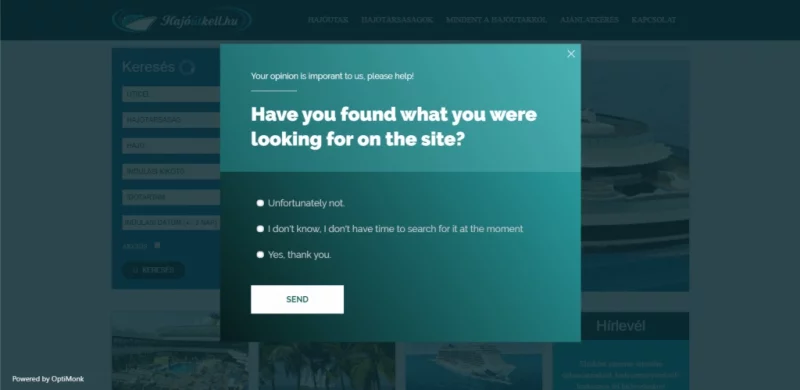
One of the simplest ways to enable feedback on a webpage is to use a popup customer survey. These surveys are tough to miss. And the simpler you make them, the more likely your customers will be to complete the survey.
Because it’s a popup, it’s an attention-grabbing way to alert your customers that you’d like to know how you’re doing in creating a great online experience.
The great news is, thanks to technology developments, you don’t even need to hire a developer to create these popup customer surveys. You won’t need to write any custom code at all.
Check out our article on 29 Website Feedback Tools that can help you set up feedback on your website with as little as a few clicks.
Creating a feedback form with Appzi is simple. Sign up for a free account, select the type of feedback widget you’d like to create, draft your questions, and copy and paste the prepopulated code into your website.
Benefits of a Popup Customer Survey
Here are the benefits of using a popup customer survey:
- Simple and fast to set up. You select the question format and wording, and many website feedback software options generate the code for you.
- Easy to customize to meet your feedback needs. Place the survey on one or all of your pages within your website and decide what action triggers the survey
- Avoids cluttering your webpages when customers are browsing. Instead of having on-page, linked text inviting customers to share their feedback, which could interrupt their website browsing, a popup appears and then disappears to allow the user to return to their regular business on the site.
- Avoids redirecting customers to a different page so that their browsing experience is not interrupted by the customer feedback. The experience is all housed right over top of the browsing experience that your customers are engaging in.
- When using a popup survey, consider how long you want the user to be on the page before the survey appears. Or make the survey be part of the checkout process where the user sees it once they’ve reached the confirmation page for their order.
Be strategic with how you use the popup survey though because you want to make sure that the visitor has spent enough time on your website to be able to offer valuable feedback instead of seeing the popup as an annoyance that they just want to close out of.
3. Incentive-based Website Feedback
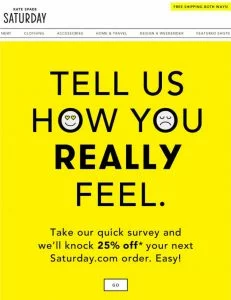
Some users need a little nudge to offer their feedback to your company. Depending on your business, you might consider offering a percentage or dollar-off discount for completing a survey.
A good use case for an incentive-based website feedback survey is at the end of a purchasing process. For completing a survey about their experience, you can offer $5 off their next purchase of $25 or more or 10 percent off their total purchase during their next visit.
Using promotions like these, you can also increase your rate of repeat customers because it’s an excuse for the customer to come back and use their promotion.
Another way to use incentive-based feedback is to enter users into a drawing for a gift card to your business. It doesn’t take large amounts of money to motivate people. Consider doing a $50 gift card drawing per 100 submitted surveys or something along those lines to give the user a reasonable expectation of winning the gift card.
You might find that a sweepstake or drawing costs your business less per survey submission and is, therefore, easier to manage on an ongoing basis.
Additionally, you could choose to only send incentive-based feedback surveys to first-time customers. This allows you to limit the incentives you pay out and get an idea of first impressions about your company.
It also might provide more insights into how you compare with your competitors since repeat customers are less likely to have experienced a purchasing process with your competitors.
Benefits of Incentive-based Feedback
Incentive-based feedback offers your customers something in return for their thoughts and feelings about your business. Here’s a look at the benefits of using this type of feedback on your website.
- Builds rapport with customers. When you give customers something in return for their feedback, you can build a deeper, more meaningful relationship with them. It shows the value of their feedback and that you’re investing in them just like they’re investing in you.
- Higher feedback survey completion rates. You’ll see fewer survey abandonments when you dangle a carrot in front of the customer for providing their feedback. This way you don’t end up with partial feedback or a low survey submission rate. Good completion rates can help improve your ability to act on the feedback because you’ll have a larger pool of data to look at.
- Increases rate of repeat customers: by offering an incentive to customers at the end of a purchasing process, you send a clear message that you’re inviting them back to purchase again. Plus, a discount or special offer can entice them to return instead of testing out your competitors’ options.
- You’re more likely to hear about the mediocre or average experiences. According to research, customers who have a negative experience with your company are the most likely ones to share their experience. But you might find the most constructive criticism within the group who find your experience just mediocre. Because they aren’t super passionate about loving or hating your products or services, they can give a level-headed analysis of their experience. But because these users aren’t especially passionate, they’re less likely to share their thoughts. Incentivizing them can help you get at this constructive criticism to grow and improve your business.
4. Offer Customers Live Chat or Bot Chat
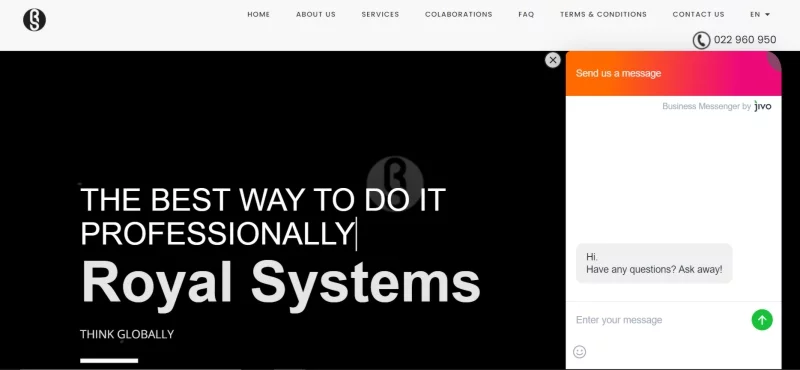
While you might not think of live chat or bot chat options as website feedback, it actually can be. If you record and categorize your chat sessions, you can see trending topics and themes to act upon for your business.
Bot chat can use artificial intelligence to point customers toward the information you want them to see. This is especially helpful for organizations with large knowledge bases. It serves as a sort of advanced search function to guide users to where they need to go.
You can combine bot chat with live chat to ensure you solve your customers’ problems for them. For example, use the bot to collect initial information. Present knowledge base topics based on keywords or phrases that the customer uses within their chatbot inquiries.
Once the user has reviewed the knowledge base, ask them if that resolves their inquiry. If not, put them in touch with a live representative who can work through the issue with them.
By recording even your live chat exchanges, you can see trends in topics and keywords. Use this data to update your knowledge base or improve your online experience.
You’ll find that the information you get from chat is quite in-depth since it’s a conversation with your customers. While it might be time-consuming to offer live chat, it’s also the most personalized way of allowing your customers to interact with you online and offer their detailed website feedback.
Not only will you gather feedback about your customer experience, but you’ll also improve your relationships with your customers and open another line of communication with them to make them brand advocates.
Benefits of Live Chat or Bot Chat
Live chat is one of the most personalized ways to get user feedback on your website. While it takes one of the largest investments because it requires staff time, it can also pay off well through repeat customers and referrals.
Here’s a look at the benefits of adding live chat or bot chat to your website feedback strategy.
- Highly personalized feedback option. In short, you can’t beat human-to-human interaction. While you put time and insights into designing your website surveys and feedback options, you won’t be able to ask every question you could possibly collect customer feedback for. But an open forum between the customer and your live chat representatives offers that open dialogue to cover any topic at any point.
- Allow visitors to have a true sounding board for their feedback. Opening up online feedback surveys, widgets and buttons on your website allows a customer to share their thoughts with your organization. But nothing will make them feel as heard and catered to as live chat. With live chat, they know that their feedback is going to a living, breathing human being who is more likely to do something with that feedback than an algorithm or survey dashboard. This can further calm negative emotions with customers who had a sub-par experience with your organization and encourage them to try your business again.
- Make feedback more human with true interaction. Some people want to offer their customer feedback and move on. Others prefer to feel like their message is being heard, loud and clear. By opening live chat as a feedback option, you make your customer feedback more human. You also humanize your brand and add a personal touch that your competitors might not be offering their customers.
- Ensure customers feel heard and cared for. Some of the most disgruntled customers can actually become your greatest advocates. That’s because they’ll see you in a whole new light when you put forward your best effort to fix the problems they faced when working with your organization. Live chat shows you’re willing to put in the time and effort to make things right and have a true relationship with the customer.
Live chat and bot chat are options you should use in conjunction with other website feedback options. That’s because collecting customer feedback means meeting the customer where they are at.
Some customers want to answer a few questions, share their thoughts and be done. They might not have the time to engage in chat and their issue might not require that much attention and care.
Combining this option with a feedback widget can help you offer constant feedback options that meet the needs of your customers.
5. Page-specific Feedback Forms to Collect Customer Feedback
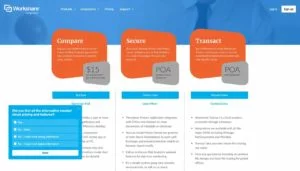
While a website feedback widget is an always-on way of collecting feedback, it’s also generic across your site. To get deeper into your user experience, create page-specific feedback forms with unique questions based on the customer buying journey.
More than likely, your business has audience subsets. Some customers might purchase from you once a week while others purchase once a year. Understanding their buying habits through feedback forms can guide you in attracting similar customers with those buying behaviors.
Map out your customer types. Your customer types might be based on total spend with your organization per year, the persona that a customer matches or simply the webpages that the customer views.
Using this data, you can create page-specific website feedback forms that ask the right questions at the right time to engage and delight these customers. With specific questions based on what you know about these customers, you can get to deeper insights and showcase that you truly understand their needs and desires.
Before you get started with this form of website feedback, know that this is quite advanced. You don’t want to start your first website feedback campaign with page-specific forms.
Instead, start gathering more general feedback first. This can help inform page-specific forms. You’ll also need to build a customer database to better understand your customer buying habits and build out detailed personas before engaging in this advanced feedback.
And another consideration when using page-specific, customer-buying-journey feedback is to avoid looking creepy. When questions are too specific and show that you know in-depth details about a customer, they might feel like you’re collecting too much of their private data as part of their online experience.
So while you want to be as specific as possible in your feedback forms, you also don’t want to look like a liability when it comes to online security and data usage.
Benefits of Page-specific Feedback Forms
Page-specific feedback forms can offer some of the deepest knowledge about a customer, without employing staff time and resources like live chat does. Here are the benefits of this way of collecting customer feedback on your website.
- Highly targeted and specific. Because you’re using what you know about the customer and their buying habits, this type of website feedback is extremely targeted and insightful. It can help you categorize your customers and learn more about what drives them to purchase from you. This allows you to attract and retain more customers like them.
- Easy to categorize. Since you’ll know what webpage your website feedback came from, you can more easily log and categorize that content. That allows you to funnel it to the right teams and departments to make the information more actionable.
- In-depth and detailed. Thanks to your insights about your customers, you can ask more in-depth questions to get to details that help you develop new products and services, offer new website functions and turn more customers into advocates to earn referrals and repeat customers.
- Actionable. The more specific your survey questions are, the easier you’ll find that it is to act on the feedback. With page-specific feedback, you’ll know more about the customers taking the survey and what motivates them. This way, you can replicate that experience for future customers through swift, clear actions.
6. Site Abandonment Surveys
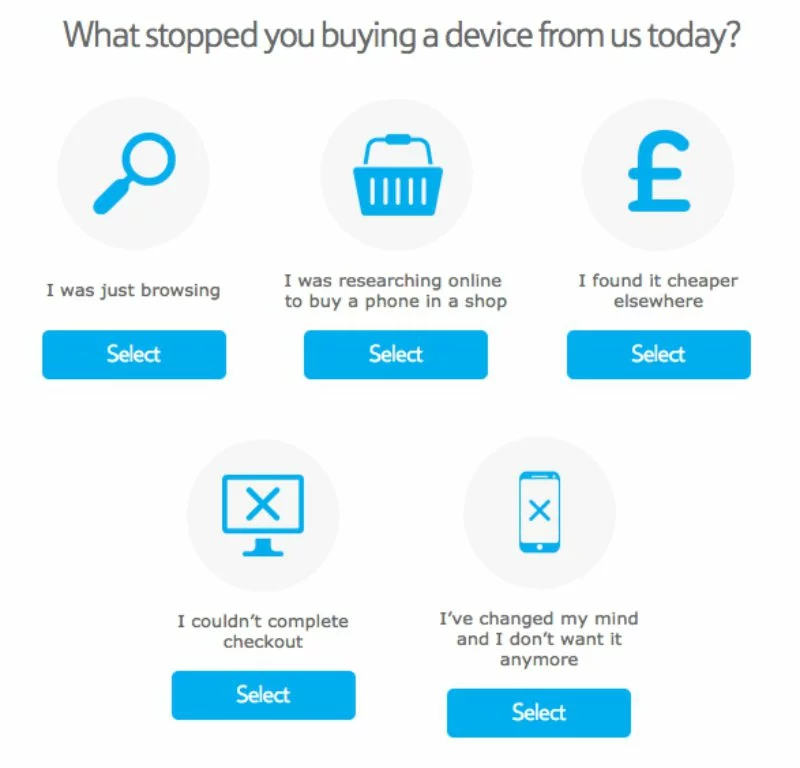
Another advanced way to collect customer feedback is through a site abandonment survey. The reason this is an advanced option is because you need a way of detecting when a customer is about to leave your site to initiate the survey.
Obviously, you can’t survey your customers after they’ve closed the web browser or tab they were using to browse your website. Instead, you’ll need to look for long pauses in scrolling, spending too long on a page or switching browser windows.
That way, you can see when a user is about to abandon your site or when they’ve opened additional content in another tab that might indicate their cross-comparing your offering to that of your competitors’.
Another way to use a site abandonment survey is to have a link or question on your product pages that allows the customer to indicate that they have questions before making a purchase. Sometimes, a simple question is the only thing that stands between a sale and site abandonment.
Offering this option to your customers allows them to get in touch with you before abandoning the purchasing process entirely. This can help you learn more about what details you need to add to your product pages or how you need to adapt your checkout process.
Benefits of Site Abandonment Surveys
Although site abandonment surveys are an advanced website feedback technique, they offer many benefits directly toward your bottom line and your customer satisfaction rates. Here’s a look at the benefits of site abandonment surveys.
- Learn how to reduce the rate of abandonment on your site. Site abandonment is a real problem when it comes to online revenue. And without insights into why this is happening, you can’t close the gaps on your website to increase that revenue. Learn how to stop site abandonment before it happens through website feedback forms.
- Improve your website conversion rate. Site abandonment means you cannot get a conversion from that website visitor. But you might not know why they came to your website and simply left. Was it your prices? Shipping fees? Missing information? Poor display on a mobile device? By asking the customer before they abandon what went wrong, you can close these gaps and improve your website conversion rates.
- Adapt product and service pages accordingly. The reason for site abandonment might be due to scarce product information. While your product or service might meet the needs of that website visitor, if those features aren’t listed on your website, you might lose the visitor. Features and benefits that seem clear to you might not be so clear to your website visitors. Ask visitors about what made them abandon your site before doing so to learn more.
- Encourage more customers to follow-through with making a purchase. By asking customers why they’re about to abandon your website, you can learn what’s wrong with your online experience and answer the visitors’ questions. By using artificial intelligence, you can present the user with the necessary information to make a purchasing decision. This might be information they felt was missing on your webpages or that they struggled to find.
- Collect information for lead nurturing on customers not yet ready to buy. An important aspect of a site abandonment feedback form is collecting user information for lead nurturing. Ask for an email address when the user completes a site abandonment form. That way, you can nurture that lead to hopefully provide enough information and convince them to come back to your site and make a purchase.
7. Select Interests to Create a Custom Experience
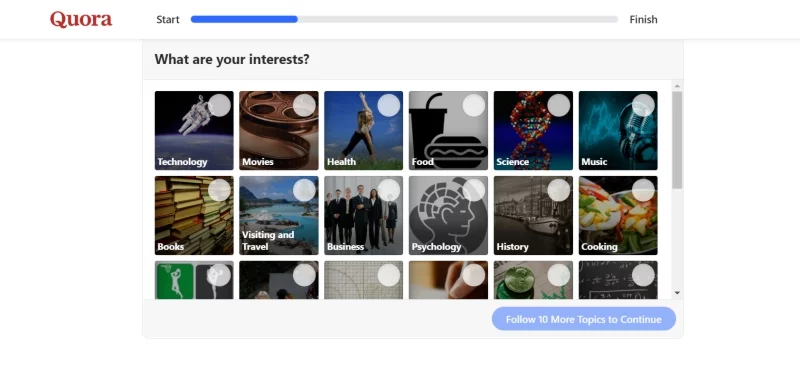
A simple form of website feedback is allowing your customer to self-select their interests. If you use progressive profiling on your site, this can help you learn more about your customers.
For example, many car websites start by asking customers what type of vehicle interests them – a sedan, SUV, minivan, truck, etc. Knowing this information can help the car website deliver content that’s relevant to the user.
But that car website can also filter results based on whether the user is searching for a new or used vehicle. With all this in mind, the moment that you have a new vehicle matching the customer’s specifications, you can notify them to close the sale.
And when you learn more about your customers’ interests, you get insights into where to put your time and effort as a business. Product development decisions are easier when you understand interests at a deeper level.
Benefits of Collecting Feedback on Interests
Self-selecting interests is something website visitors are probably already doing on your website in some way or another. But if you aren’t using that data to learn more about them, you’re missing out on a customer feedback opportunity.
- Learn more about your customers. Information about customer interests is always helpful in guiding next steps for your organization. While the clicks on your menu items on your website can offer these details as well, syncing up that data with other information you know about the customer makes the information more valuable.
- Get insights into product development. The more you know about your customers’ interests, the easier it is to develop new products and services that appeal to your customers, solve their problems and delights them in new ways that your competitors aren’t doing.
- Build out website content related to interests. When you know and understand your customers’ interests, you can develop your website content further to provide the right information that leads to conversions.
8. User Reviews as Public Customer Feedback
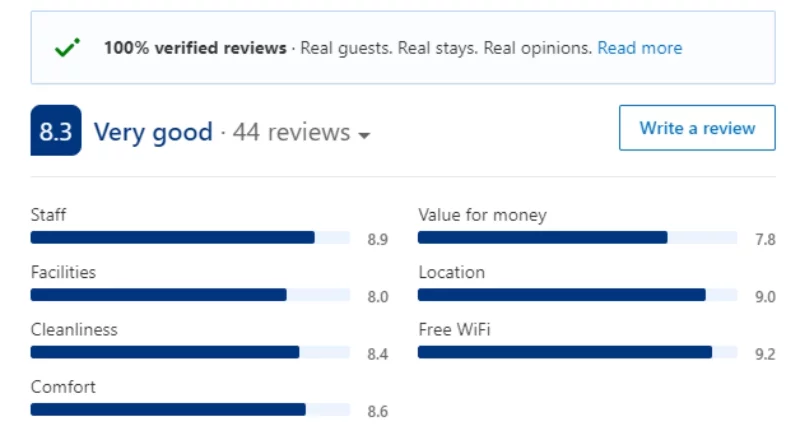
User reviews are a public form of customer feedback. When a user leaves a review on your website about a product or service, it offers social proof for future visitors to learn about your products and services.
Plus, user reviews still provide trending topics and themes for your team to use to update your product and service offering.
Choose a user review system that provides a dashboard with topic tracking to ensure you get this twofold benefit of both showcasing these reviews to future customers and getting insights for updating your offering.
Benefits of User Reviews
Some companies are hesitant to allow public feedback on their website via user reviews. However, these public reviews can help nudge a website visitor toward making a purchase.
According to research, 93 percent of consumers say that user reviews influence their purchasing decisions.
Here’s a look at the benefits of user reviews as a website feedback option.
- Provide social proof of your products’ benefits and use cases. You can talk about how great your products and services are, but nothing is as impactful as another user explaining the true benefits they earned from your products. Customer reviews are viewed as unbiased because they come from someone who has direct experience with your products and services.
- Build purchasing confidence in potential customers. Taking the leap to try new products and services can be challenging for some consumers. But online reviews can build these consumers’ confidence to know that they are making the best decision based on their needs and the problem they are trying to solve.
- Learn about recurring issues or shortcomings of a product or service. By following trends, you’ll get the opportunity to respond to these recurring themes and adapt accordingly before they frustrate other customers.
- Increase customer loyalty. Online transactions can feel one way. The customer inputs their information and gets a product but there isn’t much relationship to a transaction like this. Reviews open two-way communication between your organization and the customer. Take time to respond to customer reviews that warrant a response and show how much your organization cares.
- Build credibility. When a product has hundreds or even thousands of reviews, it can help build that product’s credibility in the marketplace. Plus, customers want to know that when they place an order, they’ll get their product without an issue. There are too many scam websites on the internet these days so customers need reassurance that your site is trustworthy.
How to Use Website Feedback Data

Collecting feedback solely for the sake of feedback won’t help you transform your business. You need to have a plan before starting a website feedback campaign of what you’re going to do with the feedback.
Website feedback serves many purposes within a business:
- Use it to develop new products and services. When you know the areas that your customers see as lacking in your current offering, you can use that data to develop new products and services to fill those gaps within your current offering.
- Identify missing features in your current product offering. Sometimes, we’re so close to our own products and services that we fail to see the missing features or the ones that are difficult to use. Customer feedback can inform and enlighten your product team to further develop its existing products and services.
- Deepen relationships with customers who provide excellent feedback. Reach out to customers who left outstanding feedback on your website. This can help you deepen the relationship with them and turn these customers into advocates for your product.
- Showcase feedback to encourage future visitors to purchase with your organization. Use quotes and reviews from your customer feedback to provide social proof of how great your offering really is. This public feedback will help inform future website visitors in making a purchasing decision.
How to Add Feedback to Your Website
Appzi makes it simple and fast for you to add feedback to your website for free! Allow users to share their thoughts with you on any webpage, at any time using a website feedback widget.

